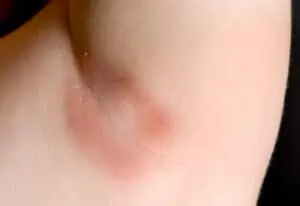
Medically reviewed by Elizabeth Leen-Burns, APRN
Did you know you can develop a yeast infection on your skin? These infections happen when yeast that normally lives on the skin grows too aggressively, leading to an itchy rash that’s hard to ignore. A yeast infection on the skin, known medically as cutaneous candidiasis, can be embarrassing because it tends to appear in areas with skin creases, such as the armpits and groin—not body parts you want to be caught scratching. A yeast infection under the breasts can be equally embarrassing.
Cutaneous candidiasis is typically easy to treat, but how do you if know you have it, and why did you develop it in the first place? Read on to learn more.
What is cutaneous candidiasis?
Cutaneous candidiasis is a common infection caused by an overgrowth of a yeast, which is a type of fungus. The yeast in this case is Candida. Small amounts of it live on your skin as well as in your digestive system and, in women, the vagina. Normally, “good” bacteria keep the yeast in check, but when the balance of good bacteria and yeast on the skin is disrupted, a yeast infection rash can result. Most Candida skin infections are caused by a species of Candida called Candida albicans.
Cutaneous candidiasis symptoms
Symptoms of cutaneous candidiasis include a red rash, small, pimple-like bumps (caused by infection of the hair follicles) and itching or burning, which can be intense.
Where the rash occurs is a tip-off that you may be dealing with cutaneous candidiasis. The infection often strikes in warm, moist, creased areas of the body, such as the armpits, groin, anus, stomach folds and under the breasts. Once an infection develops, it can spread beyond these locations.
What causes a yeast infection on the skin?
There’s no shortage of reasons you might develop a fungal skin infection, and some of the contributing factors are hard to avoid. They include:
- Hot, humid weather
- Wearing tight synthetic clothing
- Poor hygiene
- Pregnancy
- Obesity
- Changing underwear infrequently
- Failing to thoroughly dry damp or wet skin
- Taking antibiotics, which kill “good” bacteria along with “bad” bacteria
- Diabetes
- A weakened immune system due to HIV/AIDS or medications that suppress the immune system, such as corticosteroids and chemotherapeutic drugs
- Skin conditions such as psoriasis and intertrigo
Cutaneous candidiasis treatments
See your dermatologist for an accurate diagnosis if you have a rash that matches the description of cutaneous candidiasis. Mild cases may go away on their own if you follow the prevention measures outlined below. Over-the-counter topical antifungal treatments such as clotrimazole or miconazolem, which kill the Candida, can ease the symptoms and help prevent the rash from spreading.
If you have a severe or stubborn case, your dermatologist will write you a prescription for a more powerful antifungal cream such as nystatin or ketoconazole.
Use antifungals for as long as directed, even if you see improvement early on. If you stop taking them too soon, the infection may linger, and the rash may return.
Preventing a yeast infection rash
Keeping your skin folds clean and dry is the secret to avoiding a yeast infection rash. These measures will reduce your risk.
- Wear loose, breathable clothing to prevent your skin from becoming damp with sweat.
- Change out of wet bathing suits and sweaty workout clothes right away.
- Bathe as often as necessary, and wash and dry your skin thoroughly.
- Change your undergarments daily (more often if you sweat).
- Apply an absorbent body powder to moist areas, after drying them thoroughly.
If you have diabetes, keeping your blood sugar within the target range can reduce the risk of a yeast infection on the skin. If you are significantly overweight, losing weight may help.
Written by Jessica Brown, a health and science writer/editor based in Nanuet, New York. She has written for Prevention magazine, jnj.com, BCRF.org, and many other outlets.





